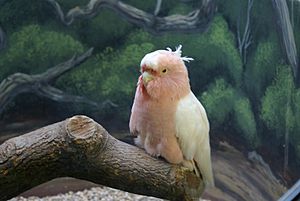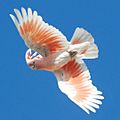Major Mitchell's cockatoo facts for kids
Quick facts for kids Major Mitchell's cockatoo |
|
|---|---|
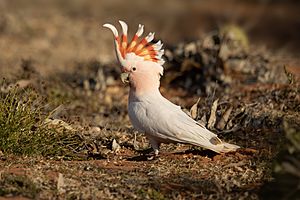 |
|
| A Major Mitchell's cockatoo with its crest raised in New South Wales, Australia | |
| Conservation status | |
| Scientific classification | |
| Genus: |
Lophochroa
|
| Species: |
leadbeateri
|
| Subspecies | |
|
C. (L.). l. leadbeateri (Vigors, 1831) |
|
 |
|
| Major Mitchell's cockatoo range (in red) | |
| Synonyms | |
|
Plyctolophus leadbeateri Vigors, 1831 |
|
The Major Mitchell's cockatoo (Lophochroa leadbeateri) is also known as the Leadbeater's cockatoo or the pink cockatoo. It is a medium-sized cockatoo found in the dry and semi-dry inland parts of Australia. You might also see it in places like South-East Queensland, which has a subtropical climate. This bird is part of its own special group, called a monotypic genus named Lophochroa.
Contents
About the Major Mitchell's Cockatoo
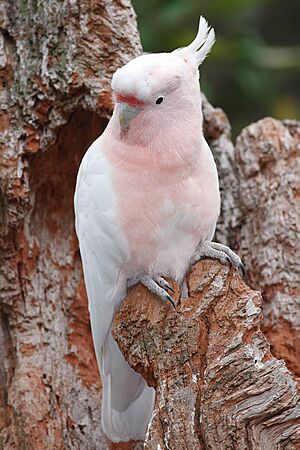
Many people think the Major Mitchell's cockatoo is the most beautiful cockatoo. It has soft white and salmon-pink feathers. Its large crest is bright red and yellow. The bird was named after Major Sir Thomas Mitchell. He once wrote that few birds make the Australian forest more lively than this beautiful species. He said its pink wings and flowing crest could make any place look more lovely.
Male and Female Differences
Male and female Major Mitchell's cockatoos look very much alike. Males are usually a bit bigger. When a female bird grows up, she will have a wider yellow stripe on her crest. Her eyes will also turn red.
Reproduction and Life Cycle
These cockatoos are ready to have babies when they are about 3 to 4 years old. They can live for a very long time. The oldest Major Mitchell's cockatoo ever recorded lived to be 83 years old!
Naming the Bird
The scientific name of this cockatoo honors Benjamin Leadbeater, a naturalist from Britain. In Central Australia, south of Alice Springs, the Pitjantjatjara people call this bird kakalyalya.
Where They Live
Unlike the galah, another type of cockatoo, the number of Major Mitchell's cockatoos has gone down. This is because of changes humans have made to the dry parts of Australia. Galahs can live in cleared or partly cleared land. But Major Mitchell's cockatoos need large areas of woodlands. They especially like areas with cypress pines, sheoak trees, and eucalypts.
These cockatoos are also different because pairs will not build their nests close to each other. This means they cannot live in places where their habitat is broken up or partly cleared. Because of this, their living areas are getting smaller. Sometimes, in the Mallee region of Victoria, Major Mitchell's cockatoos and galahs nest in the same areas. When this happens, they have sometimes had mixed babies.
What They Eat
Major Mitchell's cockatoos mostly eat seeds. They especially like seeds from native cypress pines and other plants found in their dry Australian homes. They also enjoy roots, bulbs, fruits, nuts, and sometimes even small insects. Their strong beaks are perfect for cracking open tough seeds and digging for food underground.
Protecting the Species
In Australia, the Major Mitchell's cockatoo is not listed as a threatened species under the Environment Protection and Biodiversity Conservation Act 1999.
However, in Victoria, this cockatoo is listed as a threatened species under the Flora and Fauna Guarantee Act (1988). This means there is a plan to help this species recover and manage its future. On the 2013 list of threatened animals in Victoria, this bird is considered vulnerable.
Famous Cockatoo: Cookie
"Cookie" was a very famous Major Mitchell's cockatoo. He lived at Illinois' Brookfield Zoo near Chicago. Cookie was at the zoo from the day it opened in 1934 until he passed away on August 27, 2016. He was 83 years old! Cookie had stopped being on public display in 2009 because he was not feeling well.
Gallery
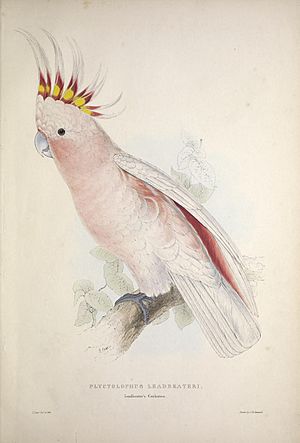
See also
 In Spanish: Cacatúa abanderada para niños
In Spanish: Cacatúa abanderada para niños



